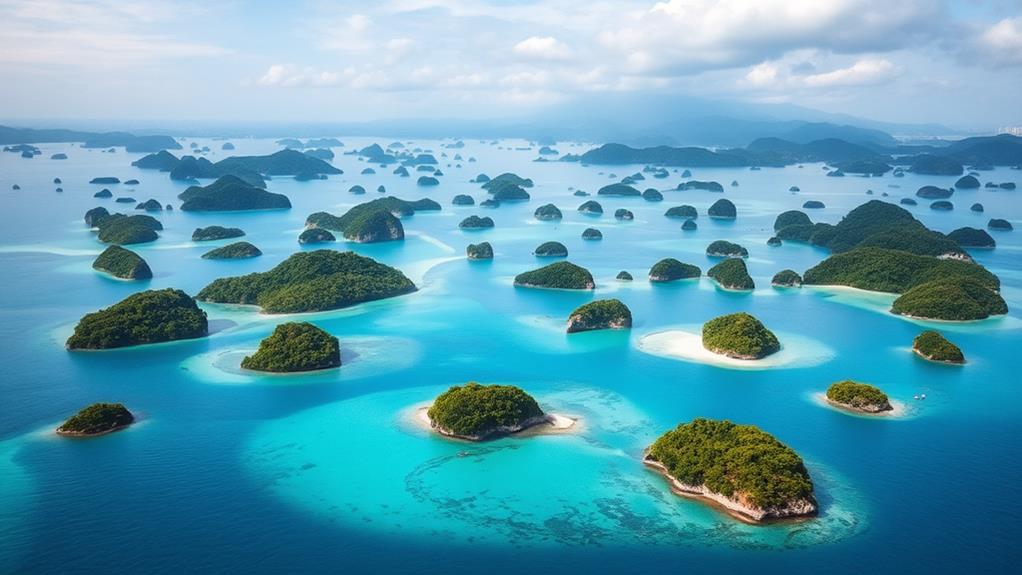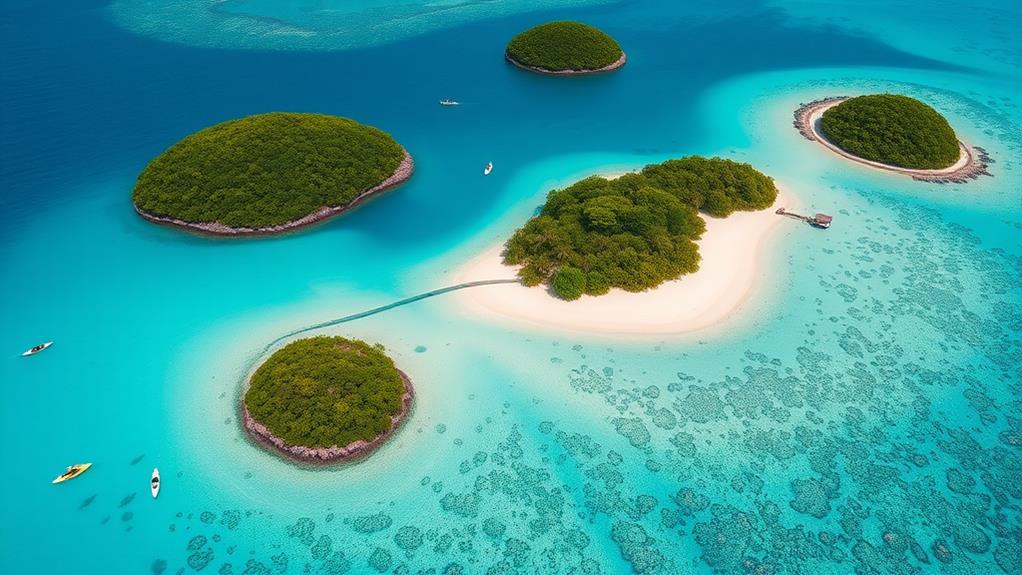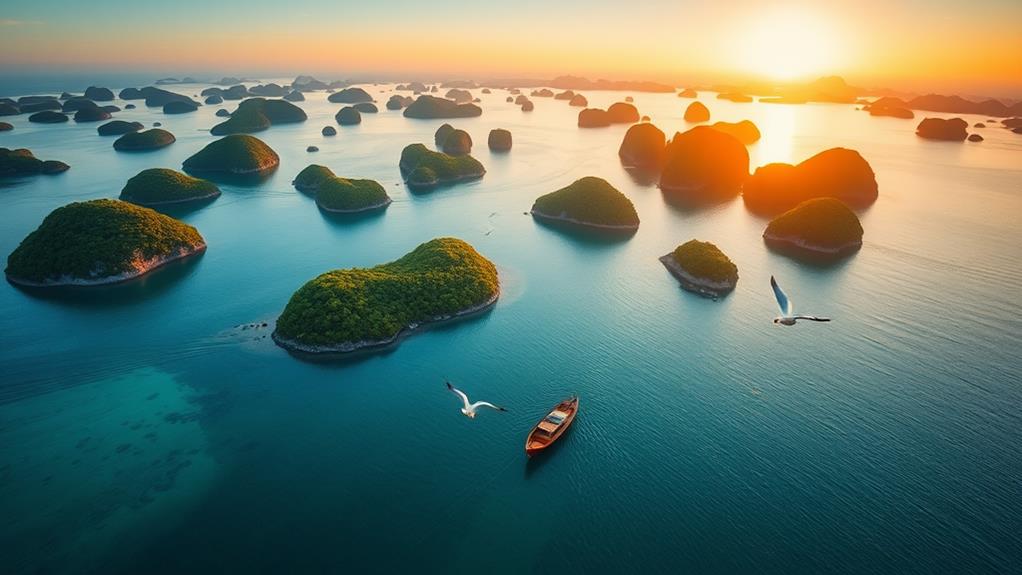The Hundred Islands National Park is a stunning cluster of 124 coral reef islands and islets scattered across 7.12 square miles of Lingayen Gulf in northern Philippines.
The park's ancient landscape, estimated to be over 2 million years old, features geological formations of limestone cliffs and coral reefs.
Only four islands are developed for tourism, allowing visitors to discover hidden gems and explore unique attractions through exciting island-hopping experiences.
The park's natural beauty and conservation come together in perfect harmony, making it an ideal destination for nature enthusiasts and those who care about the environment.
Location and Geography of HINP

Location and Geography of HINP
The Hundred Islands National Park is situated in the Lingayen Gulf, Pangasinan, in the northern part of the Philippines.
This breathtaking archipelago consists of 124 coral reef islands and islets that emerge at low tide, covering an area of approximately 7.12 square miles.
The unique geological formations of the islands, featuring limestone cliffs and coral reefs, are estimated to be over two million years old.
Only four of these islands are developed for tourism, ensuring the preservation of the park's natural ecosystems while allowing access to its scenic beauty.
Established in 1940 via Presidential Proclamation No. 667, the Hundred Islands National Park is recognized as the first national park in the Philippines.
Wildlife and Biodiversity Conservation
The Hundred Islands National Park is a biodiversity hotspot, boasting a unique geology that supports an astonishing array of wildlife and ecosystems. This park is home to a diverse range of wildlife, including the grey-backed tailorbird, lemon-throated warbler, and Philippine duck, which contribute to the park's rich biodiversity.
Conservation efforts in the park focus on protecting coral reef ecosystems and the habitats of various marine species. This ensures the preservation of the area's natural beauty and maintains the health of marine ecosystems surrounding the islands. To achieve this, the park's significant aquatic life is closely monitored.
To preserve the park's ecological integrity, tourism development is limited to only four islands. This restriction allows for the continued conservation of the park's natural wonders.
The Sagip Lingayen Gulf Project has identified key species, such as macaques and pythons, highlighting the importance of habitat protection for maintaining the park's biodiversity.
Activities and Experiences in the Park

Explore the Hundred Islands National Park
The Hundred Islands National Park offers a range of exciting activities and experiences for visitors. Island-hopping is a must-do, allowing you to discover hidden gems and create unforgettable memories.
You can explore the park's vibrant coral reefs and diverse marine life through scuba diving or snorkeling around Governors Island and Quezon Island.
Kayaking is another fantastic way to experience the park's beauty, allowing you to paddle through calm lagoons and hidden coves at your own pace.
Governors Island features a scenic 180-step View Deck, providing breathtaking panoramic views of the archipelago. For thrill-seekers, there's a zipline to get your adrenaline pumping!
Family-friendly activities are also available, with Children's Island offering shallow waters for safe swimming and picnic areas for a leisurely lunch.
The park's beautiful beaches, exciting water activities, and stunning vistas make it an ideal destination for everyone.
Trails and Exploration Opportunities
Hundred Islands National Park offers a unique exploration experience focused on aquatic adventures. Unlike traditional parks, it features leisurely walks on developed tourist islands rather than extensive hiking trails.
Governors Island is an exception, offering a short hike that culminates in a breathtaking view deck with panoramic views of the surrounding archipelago.
Accessible beaches can be reached via boat tours, allowing visitors to stroll along the sand.
The real adventure lies in the water, where visitors can kayak, snorkel, or scuba dive to uncover the secrets of this marine wonderland.
Paddling or swimming through crystal-clear waters provides an exhilarating and serene experience, showcasing the park's natural beauty.
This aquatic exploration allows visitors to fully appreciate the unique charm of each island.
Conservation and Protection Efforts

Preserving the Marine Wonderland
The Hundred Islands National Park's conservation efforts are dedicated to safeguarding its unique coral reef ecosystems and diverse wildlife.
The park's natural state is maintained by protecting undeveloped islands and promoting responsible tourism practices.
Conservation Initiatives
Habitat Protection focuses on safeguarding habitats for notable species, such as the Grey-backed Tailorbird and Philippine Duck.
Environmental Protection promotes responsible tourism practices to preserve aquatic life and coral reefs.
Sustainability efforts include educating visitors on proper waste disposal and installing solar-powered lamp posts to reduce the park's environmental footprint.
Biodiversity conservation aims to preserve the park's natural state and protect key species within marine life and island ecosystems.
Community Engagement raises awareness on environmental protection among local communities and tourism operators, promoting eco-friendly practices to ensure the park's long-term preservation.
Visitor Information and Guidelines
Getting to the Hundred Islands National Park
To visit the Hundred Islands National Park, drive from Manila to Alaminos City and then head to Lucap Wharf, the main departure point for island hopping.
Check the latest entrance fees and activity costs to budget accordingly.
Accommodations and Dining
In Alaminos City, you'll find a range of accommodations, from budget-friendly inns to luxury resorts.
Restaurants in the area serve fresh seafood and local delicacies.
Registration and Environmental Guidelines
Before exploring the islands, register at Bued to ensure you're aware of and adhere to environmental guidelines.
This helps protect the park's fragile ecosystem.
Respect the park's guidelines to preserve this unique wonder for future generations.
Exploring the Islands
With your registration complete, you're ready to explore the islands, discover hidden coves, and experience the natural beauty of the Hundred Islands National Park.
Exploring the Developed Islands

Hundred Islands National Park's Developed Islands
Hundred Islands National Park is home to several developed islands, each with its unique character and attractions. Some islands offer snorkeling and diving opportunities, while others are perfect for picnicking and camping. Visitors can also enjoy activities like kayaking and spelunking, with the option to go on an underground river exploration to discover hidden gems within the islands. The park’s diverse offerings make it a popular destination for nature lovers and adventure seekers alike.
Quezon Island: Action-Packed Adventures
Quezon Island offers facilities for picnicking, a guest house, and activities like helmet diving and kayaking, making it an ideal spot for an action-packed day.
Governors Island: Panoramic Views
Governors Island boasts a 180-step view deck that provides a 360-degree panoramic view of the surrounding archipelago. For thrill-seekers, it also features a zipline.
Children's Island: Family-Friendly Fun
Children's Island is a great destination for families, with shallow waters for safe swimming and picnic areas.
Marcos Island: Spelunking and Snorkeling
Marcos Island is a must-visit for adventure enthusiasts, featuring the Imelda Cave, which is suitable for spelunking and snorkeling.
The island's crystal-clear waters offer a glimpse into unique geological formations and marine life.
With so many developed islands to choose from, you're sure to find the perfect spot for your thrilling adventures in Hundred Islands National Park.
What Makes The Hundred Islands National Park Unique Compared to Samal Island in Davao?
The Hundred Islands National Park stands out from resorts and beaches in samal island as it offers over a hundred picturesque tiny islands to explore. Each island has its own unique rock formations and pristine beaches, making it a paradise for nature lovers and adventure seekers.
Preserving the Natural State of HINP
Preserving the Natural State of Hundred Islands National Park
Beyond the excitement of exploring the park's developed islands lies a deeper commitment to preserving its natural state. Only a handful of islands have been developed for tourism, leaving the majority of the park's untouched natural habitats intact. This allows conservation efforts to focus on protecting significant habitats for notable wildlife, including marine species and endemic bird species found in the region.
Conservation efforts prioritize protecting key species and ecosystems. The Sagip Lingayen Gulf Project highlights the importance of preserving coral reef ecosystems and diverse wildlife.
By supporting conservation initiatives, you can help preserve the park's natural state, ensuring its beauty and biodiversity thrive for generations to come.
Responsible tourism practices are crucial in minimizing ecological disruption. You're encouraged to promote environmental awareness and engage in responsible tourism practices to preserve the park's natural wonders.
Frequently Asked Questions
What Is Special About the Hundred Islands?
The Hundred Islands' Unique Ecosystems
The Hundred Islands are characterized by ancient geological formations that have shaped their ecosystems.
These unique ecosystems support a diverse range of wildlife, including rare birds and marine species.
Island Hopping and Cultural Heritage
The islands' rich cultural heritage can be experienced through island hopping, which offers breathtaking scenic views.
Visitors can also enjoy exciting water activities that highlight the islands' natural beauty.
Can We Swim in Hundred Islands?
You can swim in Hundred Islands. The islands offer shallow waters and calm conditions during the dry season, making it an ideal spot for swimming.
Children's Island is one of the best beaches for swimming, but be sure to follow safety guidelines, such as wearing protective footwear and avoiding strong currents.
Snorkeling is also an option, particularly around Governors and Quezon Islands, where you can spot vibrant marine life.
Before swimming, check tidal considerations and swimming regulations to ensure a safe and enjoyable experience.
How Many Islands Are in Hundred Island National Park?
124 islands and islets make up Hundred Island National Park.
At high tide, 123 of these islands are visible, while all 124 islands are revealed at low tide.
This unique island ecosystem is a biodiversity hotspot, featuring fascinating geological formations shaped over two million years.
How Long Does It Take to Get From Manila to the 100 Islands?
The journey from Manila to the Hundred Islands typically takes 5 to 6 hours.
This duration covers a distance of approximately 250 kilometers by bus or private vehicle. You can take public bus services or fly into Lingayen airport, but be prepared for additional transportation to Alaminos.
To avoid peak periods and high costs, plan ahead and consider the cost of transportation methods.